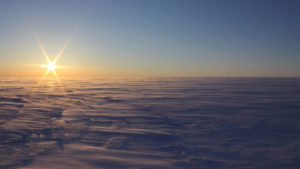‘I didn’t expect them to be there,’ says University of Alberta scientist

Scientists from the University of Alberta have accidentally discovered the first two subglacial lakes found in the Canadian Arctic — and their unique conditions could help scientists in their search for life beyond Earth.
The two lakes were found underneath the ice cap, below between 550 and 750 metres of ice.
The discovery was made by Anja Rutishauser, a PhD student in radio glaciology, who was studying the bedrock conditions underneath the Devon Ice Cap, one of the largest ice caps in the Canadian Arctic.
“I was not looking for the subglacial lakes specifically, because I didn’t expect them to be there,” Rutishauser said. “I did the analysis multiple times, because I was, like, ‘Can I really trust this?’ “

She was studying radar data when it showed there was water underneath the ice — which seemed impossible, because the temperature is below –10 C.
“It was kind of impossible to have liquid freshwater there,” she said. “I got excited in trying to figure out what’s going on there.”
Rutishauser studied radar data of the bedrock beneath the lake and concluded that the water is hypersaline — four to five times saltier than seawater.
Her guess is that the rock salt from the bedrock dissolved into the water, which allowed the water to remain in liquid form in colder temperatures.
She hopes to drill down to collect a sample of the water to measure its salinity and see whether there are microbial life forms beneath the ice.
The lakes are the first two hypersaline subglacial lakes ever discovered on Earth.
“Those lakes are super unique, and worldwide and that’s very exciting,” Rutishauser said.
There are 400 other known subglacial lakes — mostly in Antarctica and some in Greenland — but those are believed to be freshwater.
Life beyond Earth
Studying subglacial lakes may give scientists a look into life beyond Earth. If microbial life forms are found in these isolated lakes, it may have evolved without any connection to the atmosphere.
“Subglacial lakes have been shown to host active microbial communities, despite the isolation from the atmosphere under extreme dark and cold conditions,” Rutishauser said.
Finding the hypersaline lakes may also provide a new window into other planets in our solar system, such as Europa, one of Jupiter’s icy moons.
Europa has an iron core and a global ocean, covered by a global ice sheet. Rutishauser said scientists think there may be hypersaline subglacial lakes underneath the ice sheet on Europa.
“When we explore the subglacial lakes in the Devon Ice Cap, this can maybe help us to better understand the possibilities and limitations of life in such extreme environments on Earth but also on other planetary bodies like Europa,” she said.
Rutishauser said there will be a more comprehensive study on the Devon Ice Cap, which will look at how the lake formed and whether the lakes are isolated or connected to other subglacial lakes nearby.
“We discovered these lakes, we know they’re there, but we actually don’t know much about them,” she said.


